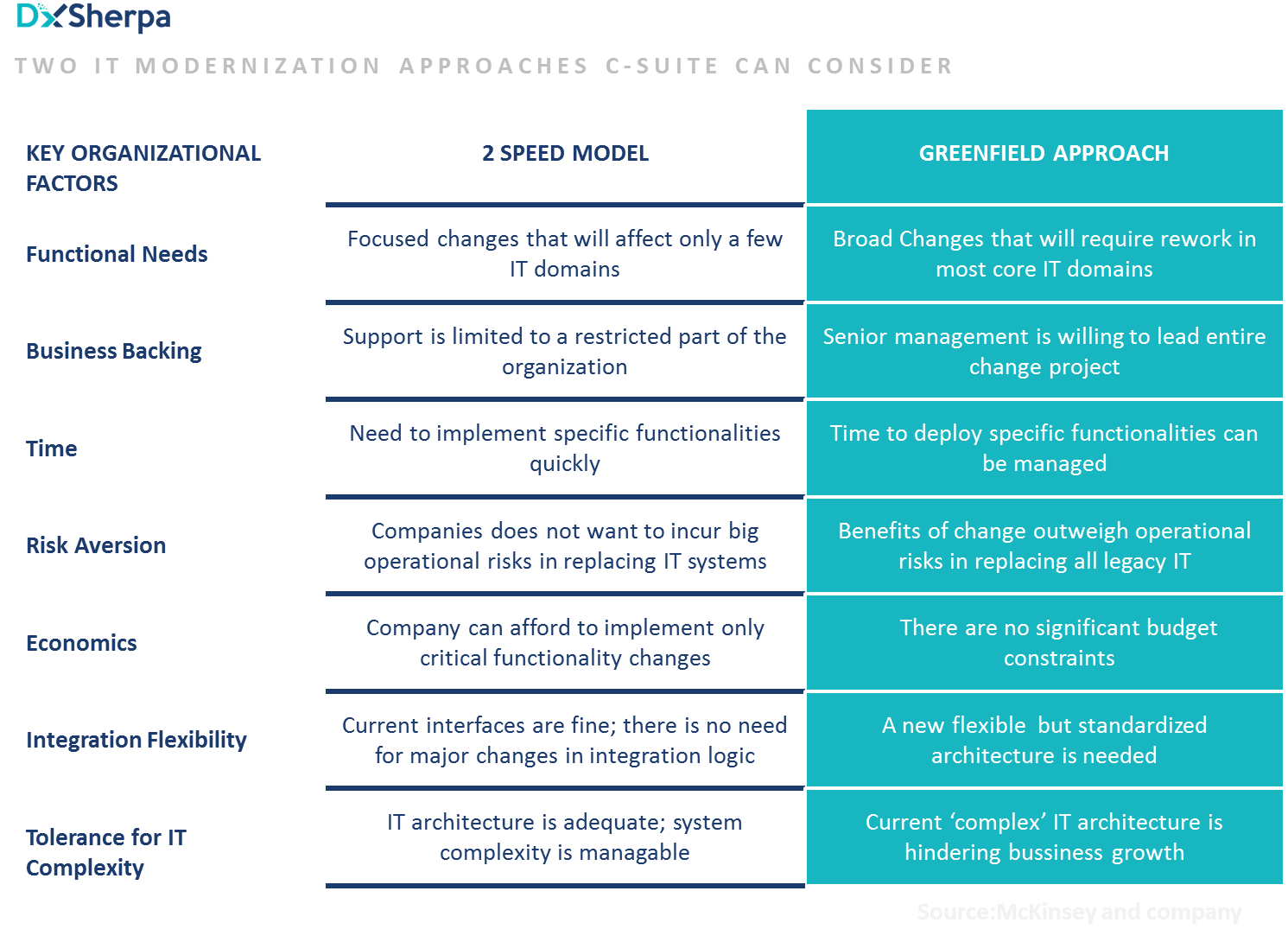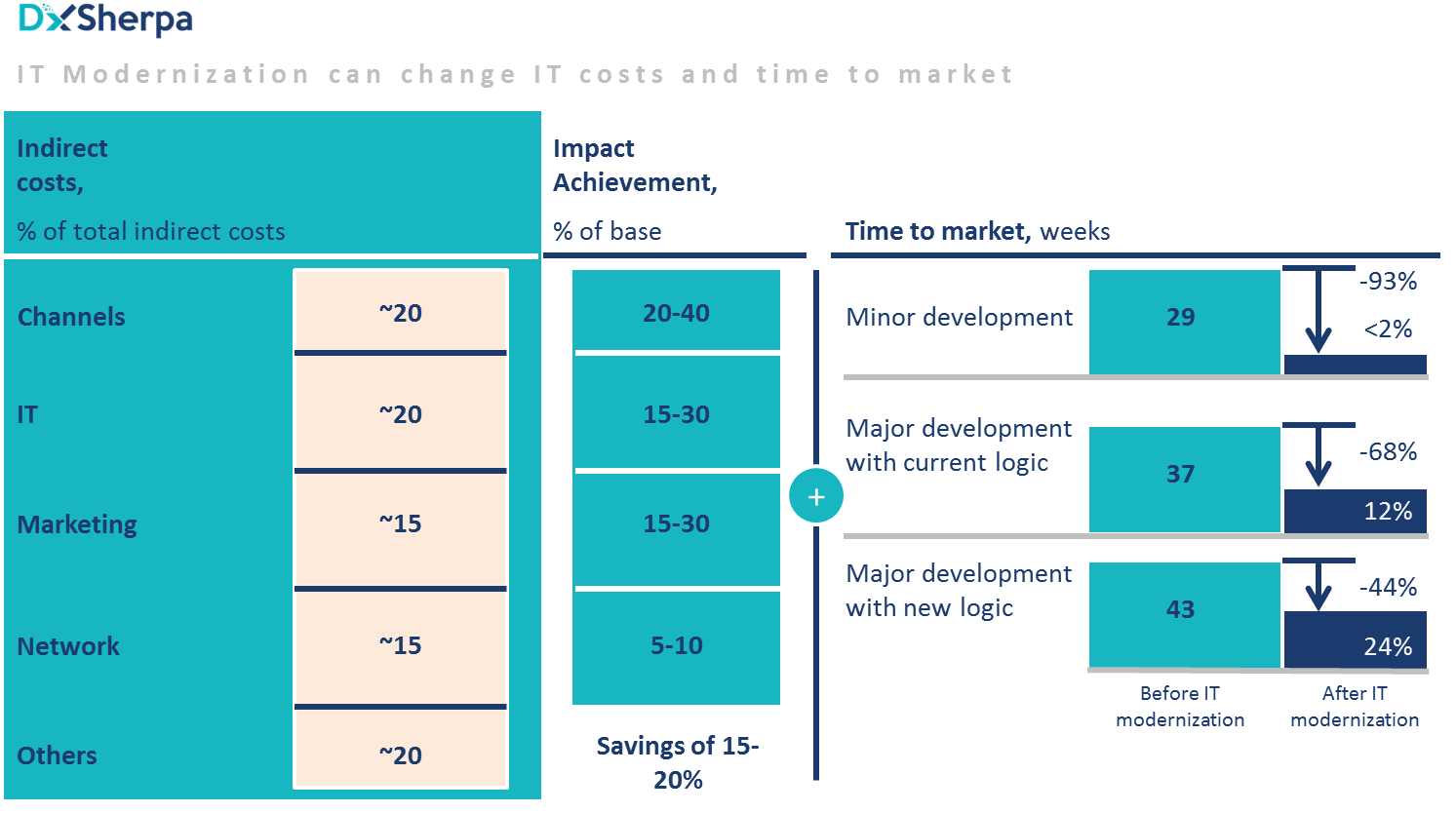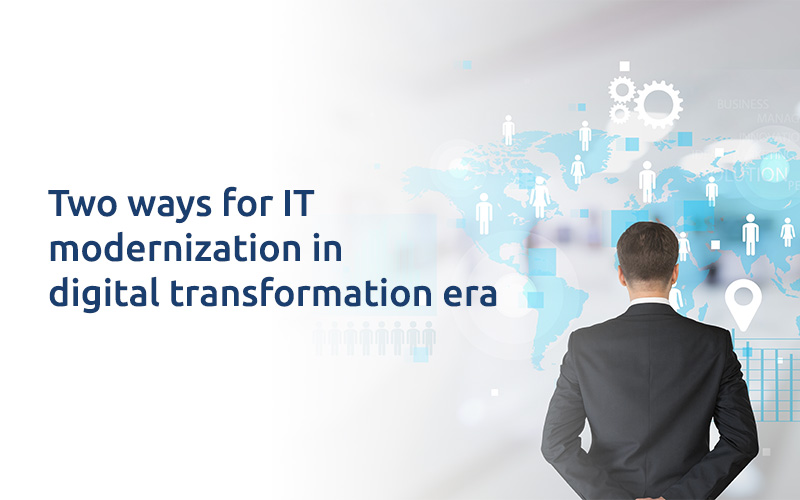
Two ways for IT modernization in digital transformation era
Companies can use two-speed or greenfield approaches to transform from IT Legacy systems to Modernized IT Systems. Which approach is right for you?
Legacy systems are the company’s biggest pain-point while focusing on successfully digital transformation and IT modernization. Every C-suite representative knows about this problem. Companies try to churn out as much success as possible from the legacy systems. When these systems come up against a problem, they devise the patch-work plan or work around. While these solutions are partly successful in short-term, they increase the operational cost in long term and miss out opportunities in terms of efficiency and innovation.
On the other hand, new online and agile competitors – having new IT modernized systems – benefit from faster product cycles, delivery systems, digital operating systems and lower operation costs. These companies are able to accelerate their time to market with new products, services and improved customer experiences. To realize the advantages, established companies need to simplify their core systems. One of the options is elimination of operational drag from legacy IT systems and improve their customer service by 10%-15%.
Based on our work with our customers, we believe two approaches may be the most effective for successful IT modernization from legacy systems. The approaches named two speed and greenfield with specific requirements (assets, financial requirements, maturity of IT System etc.) will give short term successful improvements and transform IT services. We will consider both approaches, the conditions under which they work the best and essentials for governance which would ensure success.
The Two Methods of IT Modernization
To obtain similar costs and performance benefits that companies need, companies need an IT architecture and workflow that is modular, simple, customer-centric and configurable. Both two-speed and greenfield approaches give companies the ability to rapidly transform themselves while allowing the business to operate at its best.

Two-speed Approach for IT modernization
Under this approach, the IT organization can produce quick iterations and launch front-end apps, customer apps and ensure stability of slower back-end systems that handle foundational transactions and record keeping.
Companies can prioritize two or three high-value customer experiences. They can have a dedicated team with digital/modernized skill set to create fast-track service for the customer experience and improve go-to-market speed. While, the IT architecture team, can operate on a moderate pace to carry on with the core work (planning and designing) of long-term enterprise architecture that can meet organization strategic and operational needs. For example, one of the banks used this approach in account opening process where they utilized our AutomationEdge bot to create Robotic Process Automation. This was tested in a live environment, constantly refining the process and steps had been cut from 15 to 5 steps. Customers now can open an account using mobile devices within 5 minutes and with paperless documents.
The two-speed model allows management to divide capital investments to mitigate risks of IT transformation projects and seamless migration. But, two-speed approach is also very complicated when it comes to hybrid architecture in which transactional platforms, managed scalability and cross-functional connect is optimized for customer experience. The companies need to focus on connecting individual improvement with underlying architecture. It is also critical for companies to set clear milestones for transformation with a comprehensive plan and investment strategy.
Greenfield Approach for IT modernization
The greenfield approach focuses on replacement of core Legacy IT system. This approach works the best when businesses need total transformation. If there is a need for quick results and crushing pressure, two-speed approach works the best.
To implement the approach, companies have several approaches. Either they can chose to build from scratch or select from best-of-breed hardware and software products. Whatever the choice, it is critical for enterprises to understand the full capability of tools and platforms they are acquiring. And rather than focusing on adaption of software packages, companies need to commit to redesigning software workflows and delivery process end-to-end with best industry practices.
There are several factors companies need to weigh at the outset like substantial capital and liquidity depending upon the scope. Of course there is a need of strategic and financial commitment over sprints divided in period of years.

Ensuring Strong Governance
Even if the company decides to follow any approach, organization needs to adhere certain best practices and governance principles.
The business management team needs to play an active role in the process. The IT modernization should be enterprise-wide exercise. Business leaders, senior management and business analyst need to be committed and engaged in the process, outlining and measuring the success the parameters.
The target IT architecture and workflow need to have an long-term vision and plan. If the company decides to divest itself into other areas, the underlying IT architecture must be robust to handle the change. Management must commit them in articulating strategy with IT, and the IT leaders must ensure that resulting architecture can meet evolving needs.
Simplification of products, services and processes would give out a better customer experience and create a sequential workflow for connectivity. This discipline would increase the company focus on IT transformation and avoid costly changes.
With dynamic dashboards, the company can create Clear and frequent communication between stakeholder about the progress, changes and effects on the current system. The metric decided, would make clear of the impact the organization will have.
